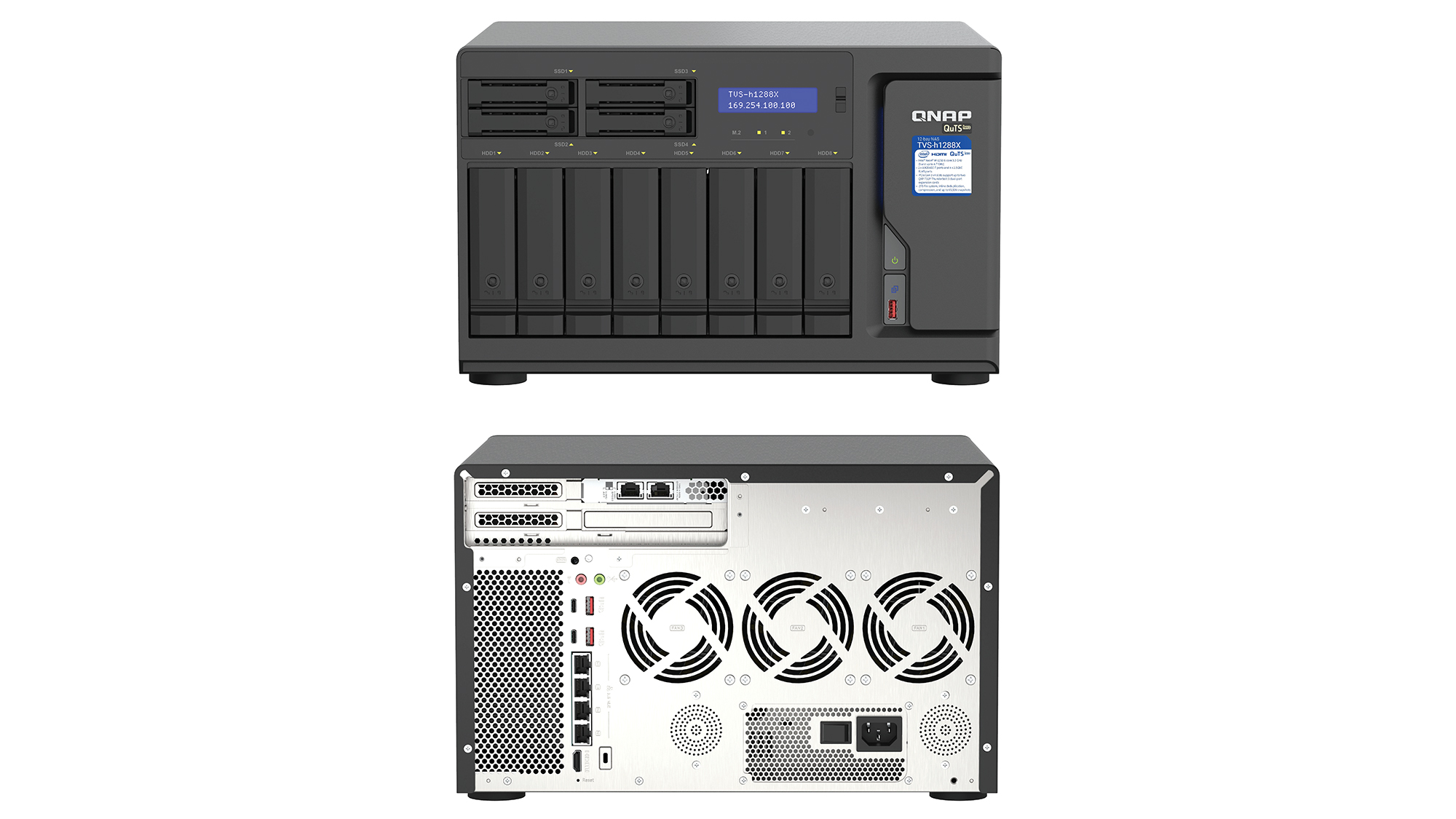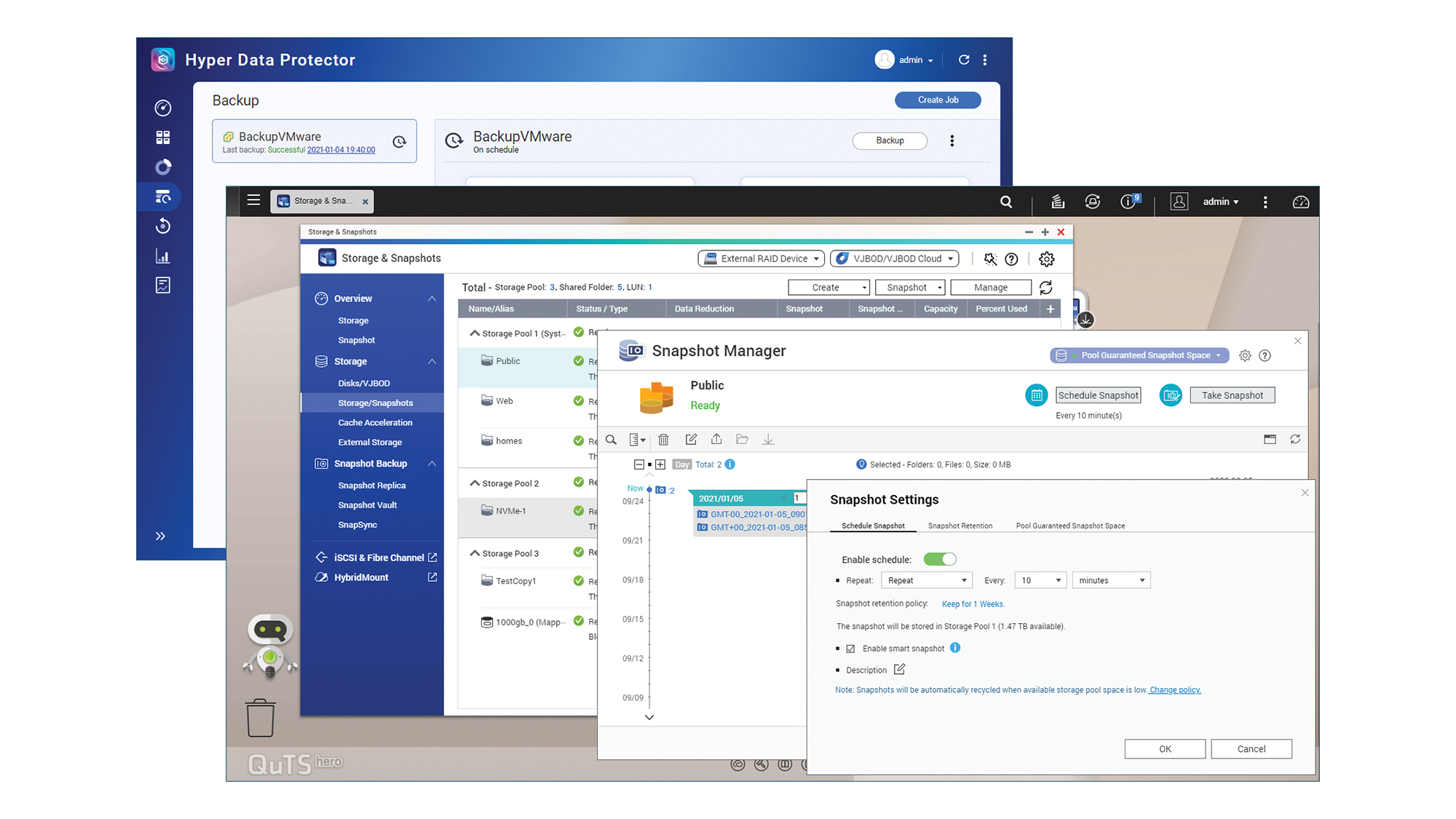Qnap TVS-h1288X QuTS hero Edition review: One heck of a box
It’s pricey, but this desktop NAS is rich in features and promises enterprise-class data protection


-
+
Speedy performance
-
+
Great expansion potential
-
+
Tons of data protection features
-
-
Expensive

Success tends to go hand in hand with excess, and Qnap’s TVS-h1288X has the latter in abundance. This imposing desktop NAS appliance provides eight LFF and four SFF drive bays, along with dual internal M.2 NVMe SSD slots – and it presents all this storage over four embedded 2.5GbE ports, as well as a dual-port 10GBase-T PCIe card.
It also enjoys all the benefits of Qnap’s 128-bit ZFS-based QuTS hero OS. This has some fantastic data-integrity features, including near unlimited snapshots, end-to-end checksums for transparent error-correction, and triple-parity and triple mirroring RAID options.
To help you make the most of your storage, the OS also offers inline data deduplication and compression, while off-site data replication is turbo-charged by the clever means of only sending changed blocks to remote appliances. For archival duties there’s WORM (write once read many) support too, to ensure that stored data can’t be tampered with.
As you’d imagine, a storage monster like this comes with plenty of power on tap. It’s built on a 3.3GHz six-core Xeon W-1250 CPU and comes with 16GB of DDR4 memory, which can be upgraded to a huge 128GB. Since the processor has an integrated Intel UHD Graphics P630 GPU, you can even connect a screen to the rear HDMI port, which supports 4K displays at refresh rates of up to 30Hz; connect a keyboard and mouse via any of the five embedded USB 3.2 ports and you can directly access the QuTS hero desktop for monitoring and management.
Naturally, the USB sockets can also be used to attach external drives, and if you want to max out the storage there’s space alongside the 10GbE card to add one or two of Qnap’s dual-port Thunderbolt 3 cards. In theory, you could use various third-party PCIe cards too, but due to the internal design of the appliance, the outer slots will only take cards of up to around 156mm in length. Qnap’s expansion cards will fit without a problem, but we found our Intel and Emulex 10GbE adapters were too long.

If you’re familiar with Qnap’s QTS software you won’t have any problems setting up the TVS-h1288X because the web consoles are almost identical. The configuration wizard starts by installing the latest version of QuTS OS and offering to create a system pool; Qnap recommends using SSDs for this, so we fitted two 1.92TB Micron 5200 Max SATA SSDs and added four 16TB Seagate IronWolf Pro drives for data-storage duties. We then used the Storage & Snapshots app to create a 42TB RAID5 pool from our IronWolf Pro drives and were impressed to see it ready immediately – with QTS we’d have expected to wait days for the build to complete.
For each NAS share you can choose thick or thin provisioning, and specify whether or not to apply encryption, deduplication and compression, as well as whether a WORM policy should be enforced. There are two of these to choose from: the Enterprise policy won’t let you modify or remove individual files but permits deletion at the folder level, while the Compliance policy protects everything, so the only way to erase data is by deleting the entire storage pool.
On top of all of this, there’s a great range of apps available. We counted 141 for this OS in the appliance’s support page, including key backup apps such Qnap’s Hybrid Sync 3, Qsync Central and HybridMount, plus Hyper Data Protector for VMware and Hyper-V virtual environments.
To test performance, we mapped a NAS share to a drive on a Dell EMC T640 Xeon Scalable server and fired up Iometer; this reported sequential read and write rates of 9.3Gbits/sec and 9.2Gbits/sec, while our real-world 25GB file copies completed at 8.3Gbits/sec and 4.9Gbits/sec respectively.
IP SAN performance over 10GbE was just as fast. Here a 1TB iSCSI target gave read and write rates of 9.3Gbits/sec and 9.1Gbits/sec. Moving to a dual 10GbE MPIO link saw speeds leap to 18.5Gbits/sec and 15.4Gbits/sec.
The TVS-h1288X is one heck of a box. The price is high, but that buys superb connectivity, plenty of storage capacity, bags of expansion potential and a wealth of data-protection features, courtesy of the exceptionally powerful QuTS OS.
Qnap TVS-h1288X QuTS hero Edition specifications
| Chassis | Desktop chassis |
| CPU | 3.3GHz six-core Xeon W-1250 CPU |
| Memory | 16GB DDR4 (max 128GB) |
| Storage | 8 x LFF SATA, 4 x SFF SATA, 2 x M.2 NVMe |
| PSU | 550W internal PSU |
| RAID support | Supports RAID0, 1, 5, 6, 10, 50, 60, triple parity, triple mirror |
| Network | 4 x 2.5GbE, 2 x 10GBaseT |
| Other ports | 5 x USB 3.2, HDMI 1.4b, 3 x PCIe (2 free) |
| Management | QuTS OS |
| Warranty | 3yr hardware warranty |
Get the ITPro daily newsletter
Sign up today and you will receive a free copy of our Future Focus 2025 report - the leading guidance on AI, cybersecurity and other IT challenges as per 700+ senior executives
Dave is an IT consultant and freelance journalist specialising in hands-on reviews of computer networking products covering all market sectors from small businesses to enterprises. Founder of Binary Testing Ltd – the UK’s premier independent network testing laboratory - Dave has over 45 years of experience in the IT industry.
Dave has produced many thousands of in-depth business networking product reviews from his lab which have been reproduced globally. Writing for ITPro and its sister title, PC Pro, he covers all areas of business IT infrastructure, including servers, storage, network security, data protection, cloud, infrastructure and services.
-
 ‘Phishing kits are a force multiplier': Cheap cyber crime kits can be bought on the dark web for less than $25 – and experts warn it’s lowering the barrier of entry for amateur hackers
‘Phishing kits are a force multiplier': Cheap cyber crime kits can be bought on the dark web for less than $25 – and experts warn it’s lowering the barrier of entry for amateur hackersNews Research from NordVPN shows phishing kits are now widely available on the dark web and via messaging apps like Telegram, and are often selling for less than $25.
By Emma Woollacott Published
-
 Redis unveils new tools for developers working on AI applications
Redis unveils new tools for developers working on AI applicationsNews Redis has announced new tools aimed at making it easier for AI developers to build applications and optimize large language model (LLM) outputs.
By Ross Kelly Published
-
 Google layoffs continue with "hundreds" cut from Chrome, Android, and Pixel teams
Google layoffs continue with "hundreds" cut from Chrome, Android, and Pixel teamsNews The tech giant's efficiency drive enters a third year with devices teams the latest target
By Bobby Hellard Published